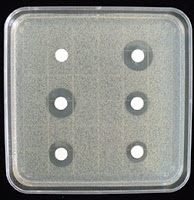 I don’t usually get many news covering biobased chemicals for coatings and adhesives and the last big one was about the partnership between Henkel and Danimer on developing bio-based hotmelt adhesives for consumer packaging.
I don’t usually get many news covering biobased chemicals for coatings and adhesives and the last big one was about the partnership between Henkel and Danimer on developing bio-based hotmelt adhesives for consumer packaging.And maybe I can also add the blog’s recent post about biobased methyl methacrylate since it is also an intermediate in the manufacture of coatings and adhesives.
However, these recent news from several companies are also aimed at developing bio-based intermediates for coatings and/or adhesives applications.
Lactic acid producer Purac has joined specialty chemicals company Perstorp in a research and development deal for caprolactine lactide co-product targeting the coatings and adhesives market. Possible uses for the renewable caprolactone lactide co-products include as polyols and as hotmelt adhesives.
The new caprolactone lactide co-products will be launched by Perstorp during 2013 and will be presented at the incoming K tradeshow (for plastics and rubbers) in Germany on October and European Coatings Show next week also in Germany. The companies said a number of lead customers have already been supplied with the new co-resins and have approved these in their final products.
Now, I am not familiar with caprolactone lactide but I know that Perstorp claims to be the world’s largest supplier of caprolactone via its Capa business. BASF and Daicel are the other two biggest producers. Caprolactone, usually produced from cyclohexanone, is often consumed internally as precursor to caprolactam (a nylon feedstock) or as a monomer to manufacture highly-specialized polymers (e.g. polycaprolactone).
Googling on caprolactone-lactide copolymers led me to several studies on their use in biomedical applications such as tissue engineering and drug delivery. Not much information out there on the use of caprolactone lactide copolymers in high-volume industrial applications.
As for Purac, the company has been already commercializing its special grade lactides for coatings, and in fact last year, launched its Puralact range for coating resins market.
By the way speaking of lactides, I just want to insert this news from Germany-based Direvo Industrial Biotechnology about their development of a bioprocess for lactic acid production using lignocellulose. According to the company, there has not been any known consolidated bioprocess for lactic acid production from lignocellulose until now.
Direvo said it has successfully built up a processing chain from pretreatment through fermentation to downstream processing. Direvo has fermented lactic acid on pilot scale in a single-step synthesis using pretreated miscanthus grass and its proprietary microorganism Caldicellulosiruptor species. The microorganisms are said to be extreme thermophile, and therefore high process temperatures don’t cause product losses through contamination with foreign bacteria.
The downstream processing was then executed in collaboration with the department of bioengineering of the Leibniz Institute for Agricultural Engineering Potsdam-Bornim. Direvo plans to increase the yield of their lactic acid for their next development stage.
Going back to adhesives and coatings, this news from EcoSynthetix said it has partnered with the Waterloo Institute for Nanotechnology at the University of Waterloo to collaborate on new applications for Ecosynthetix’ EcoSphere biolatex polymer technology. The company touts its EcoSphere technology as a drop-in replacement for styrene butadiene and styrene acrylic latex.
The five-year partnership will be jointly funded through an EcoSynthetix and NSERC (National Sciences and Engineering Research Council) Collaborative Research and Development Grant. The project’s focus is near-term product development and product enhancements of carbohydrate-based biopolymers. The researchers will be chemically modifying the nanoparticles and then characterizing how the properties of the novel particles are affected by these changes, according to EcoSynthetix.
Speaking of nanomaterials, and getting sidetrack again from the main topic, is this news from Cereplast about its newly acquired patent for biodegradable nanopolymer compositions. Patent 8,389,14 describes biodegradable compositions such as polylactic acid (PLA) and other other components, and incorporates nanofillers that improve physical and thermal properties of the material.
Cereplast claims this patent is the first for biodegradable nanopolymer compositions.
Other coatings-related news that are stewing in my draft box for quite awhile is this CKB packaging board from Finnish paper products and packaging company Stora Enso. This year, Stora Enso launched its CKB packaging board now coated with biobased polyethylene developed in partnership with Swedish company Trioplast/Ekmans.
The biobased PE coating was manufactured by Braskem in Brazil using sugarcane for feedstock. The first consumer products that will be available in packages coated with the new laminate are fish gratin products of the Norwegian fish and seafood company Domstein ASA, according to Stora Enso.
 |
| Polymer films showing strong antibacterial properties in several sterile paper disks |
Meanwhile, researchers from Iowa State University have developed soybean oil-based coatings that have antibacterial properties. The researchers incorporated cationic charges into the polymer structure to make the coatings antibacterial. Cationic compounds have the ability to bind to bacteria and other microbes and disrupt their structure, leading to cell injury and/or death.
Potential applications for the soy-based antibacterial coatings include food packaging, in food processing plants or in hospital operating rooms. The researchers continues to investigate the performance of the product as well as other coatings against multi-drug resistant bacteria, fungi and viruses.
As the blog always want to get some market data, this 2012 study by Global Industry Analysts reported that the global coatings market is expected to reach 8.7bn gallons in volume and $107bn in value by 2017.
FOLLOW ME ON THESE SPACE
Great Content, Bonding and withstanding a lot of forces are still the basic items of today’s latest adhesives developments. Hardly any other field is as chemically and technically diverse as that of adhesives.
http://www.parsonadhesives.com/partite-parbond/epoxy-adhesives.htm
Posted by Epoxy Adhesive | May 11, 2013, 12:44 am